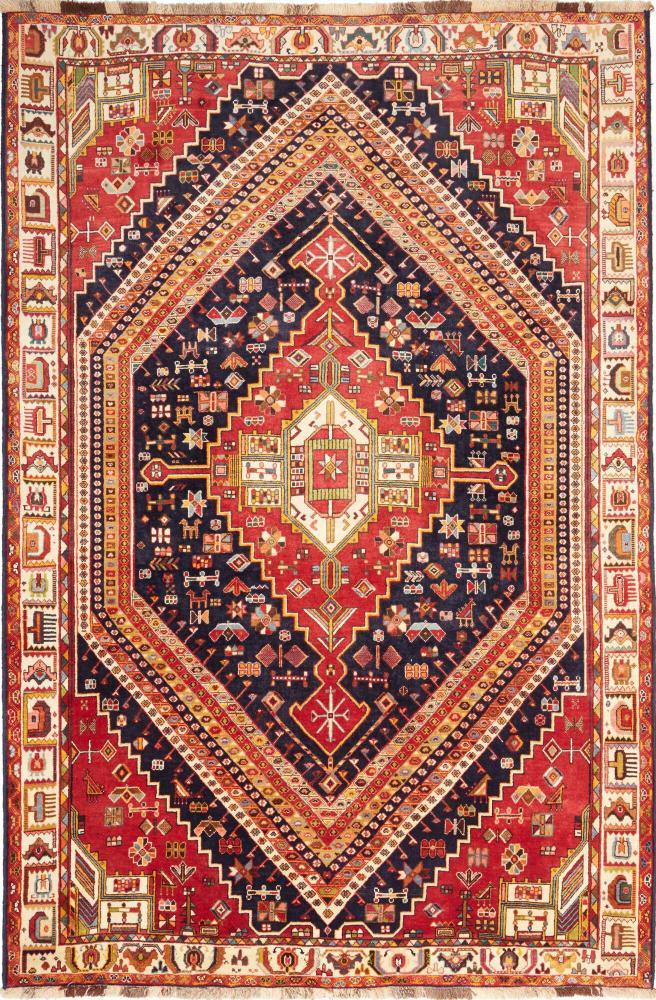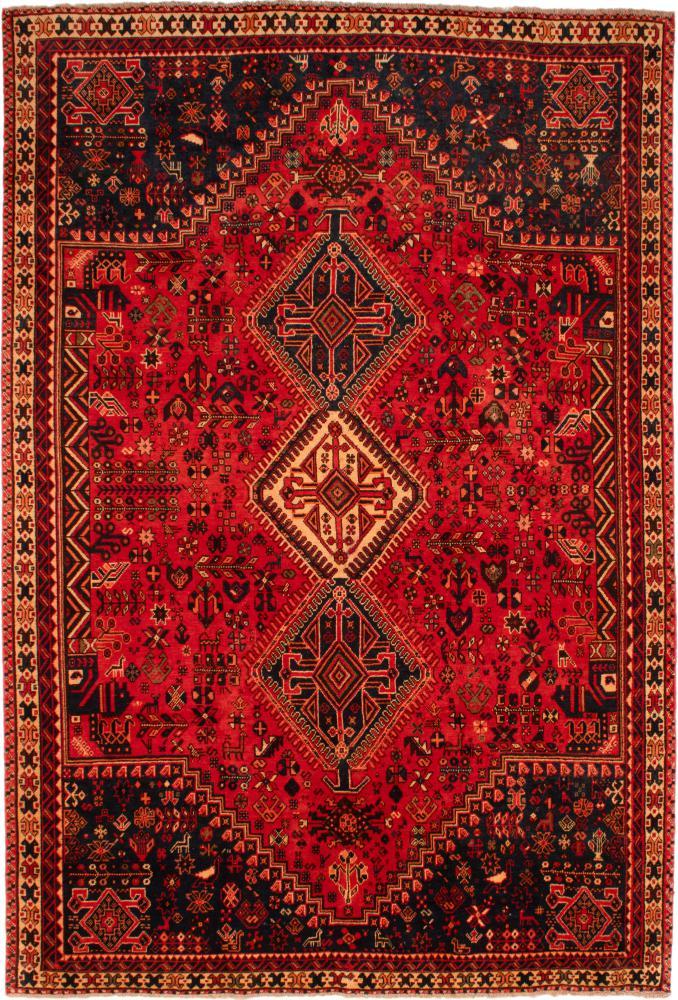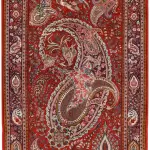Introduction of Qashqai handwovens
The Qashqai tribe is one of the nomadic tribes of Iran that came to Fars province centuries ago and settled there. In terms of color and patterns, Qashqai handwovens are one of the most beautiful and amazing handwovens in Iran and they are famous abroad as well. If these beautiful and happy handwovens are thrown on horses and mules among the Qashqai nomads, instead they find a place on the couch or sofa in luxurious European apartments or replace paintings on the interior walls of the building. In this article, we are going to introduce you to these beautiful and unique handwovens.
History of the Qashqai tribe
The Qashqai tribe is the largest tribe of Fars province and even Iran, which has settled in this land since ancient times. According to the historical evidence, the various ethnic groups of this tribe migrated to this land from the western regions of the Caspian Sea (Azerbaijan and the Caucasus) as well as its eastern regions (Turkmenistan and the northern regions of Khorasan), but what is certain is that their migration from the northern regions was not done all at once and Various Qashqai tribes have gradually migrated to Fars. The Ili system was established among the Qashqais at the end of the Safavid period and organized the scattered groups of Khalj and Qashqais under a single system. This large tribe is Turkic and they speak Turkish, the main center of this tribe is Fars province, but due to the vastness of Yilaq and Qashlaq areas, they also live in other provinces.
Qashqai tribe handwovens
Qashqais are an artistic people and their works of art have been world-renowned for many years, and it can be said that Qashqai carpets and rugs have no rivals in Iran and even the world, and have become famous under the name of Shiraz Turkish carpets. Carpet weaving is an art that is done by Qashqai women and girls. These handlooms only meet the needs of the family and the economic aspect has not been mentioned at all. With the arrival of the heads of the Qashqai tribe to Fars, the art and craft of carpet weaving in this region got a new boom and this industry was more and more concentrated in tribal areas. This is the basic characteristic of Persian carpet weaving, which is a nomadic and rural art and craft, and above all nomadic.
The oldest Qashqai handwovens
There are only a handful of old Qashqai handwovens, the age of the oldest Qashqai carpet in the world does not reach three hundred years, so it is difficult to understand how the Qashqais who came to Fars about 600 years ago wove carpets and what designs and patterns they used. Siros Parham considers Nomadic carpet weaving to be a traditional art that adheres to tradition, which, while being impressive, rarely undergoes changes and transformations. There are patterns in the Qashqai handwovens that have been used unchanged for hundreds of years, and on the other hand, there are designs and patterns that the weaver has changed according to his own taste or familiarity with new patterns and ideas. It is combined with other motifs of weaving fields and creates new motifs. The main reason for the continuation of carpet production in the ancient way in the Qashqai tribe is the continuation and dominance of the nomadic way of life and the prosperity of nomadism. After their gradual arrival in Fars in the 8th century of Hijri, the Qashqais combined their ancient tradition of carpet weaving with the ancient patterns of Fars and made this art prosper and excel.
Qashqai women, creators of art and beauty
Qashqai clan weavers are the best of all nomadic carpet weavers in Iran and the world, and Qashqai women's hand weaving has been the best example of nomadic carpet weaving until about half a century ago. The free and colorful imaginations left by the nomadic women of the Bozor tribe in the field of their handlooms are unique, and this uniqueness of Qashqai patterning and coloring is not limited to the land of Fars or other tribes and villages of Iran, and includes many woven urban carpets in most parts of Iran. . The originality and creativity of patterning and the strength and freshness of coloring have reached perfection in the Qashqai carpet. This is a Qashqai carpet that has recorded the name of the Qashqai tribe in the history of world civilization and culture. There is no end to the variety of colors and designs of Qashqai carpets. The scope of this variety in the world of carpet weaving sometimes reaches infinity. And this is why Qashqai handwovens always surprise us. In addition to rugs and carpets, the Qashqai people also produce other handwoven items such as gabe, rugs, jajim, khurjin, chinte, jwal, all kinds of ropes, bedding, salt shakers, etc.
The method of texture and color in handwoven Qashqai tribe
Qashqai people set up their dars on the ground horizontally, which is actually a tradition of nomadic life. Nomadic carpets are woven using asymmetric Persian knot. The Qashqai people choose wool for their original and beautiful carpets and in some cases they also use goat and camel wool. Fars carpets and rugs are mostly double weft and have thick, blackish brown threads, and they use red weft and are reluctant to use white weft; Because they believe it makes the back of the carpet dull. Tasteful Qashqai weavers sometimes decorate their carpets with beautiful colored tassels.

Dimensions of Qashqai carpets
The dimensions of the carpet among the Qashqais are often small and in the sizes of a cubit and a half, a curtain, a six-meter square, and a four-meter square. The texture of larger dimensions is not common among Qashqais.
Weaving process in Qashqai carpets
The weaving process of Qashqai handwovens is a mental weaving, memorizing texture and improvisational weaving, and in some cases, they get inspiration from other carpets, which are called orders, and perform the weaving work. Qashqais weave less during migration and more in the summer months in the cool and high altitudes of South Zagros.
The reasons for the fame of Qashqai handwovens
The freshness and transparency of the color and the variety and richness of coloring have been more effective than any other factor in the world fame of Qashqai handwovens. The ability of Qashqai women to feel colors and coloring is also due to the abundance of colors and details of coloring, and the maturity and attractiveness of the colors, and the attractive and charming harmony that creates the unique beauty and variety of colors. The obvious difference between the Qashqai carpet and the most colorful Illyrian and rural handwovens, from other parts of Fars to Bakhtiari, Turkmen, and the Caucasus, is in the Qashqai "miniature" coloring, which sometimes reaches the microscopic level. The difference between a premium and colorful Caucasian rug and a first-class Qashqai rug is not only that the former never has more than twelve colors and the latter sometimes has up to twenty distinct colors, but the difference is that a premium Caucasian hand-woven has pieces of good colors. However, an exquisite Qashqai is a combination of particles of bright colors.
In the art of Qashqai carpet weaving, the intense red color of Fars, which is known as flower color, is considered the basic color, followed by brown, blue, yellow and gold colors.
Patterns and motifs in Qashqai handwovens
The design and role of each carpet is what makes it beautiful and eye-catching, and after painting, it is the best factor of the carpet's credibility and value. Designs and patterns are one of the most important and prominent aesthetic elements in Iranian handwovens. Pattern in Iranian handwovens is the only fundamental element that is always taken into consideration. Designs and motifs in Iranian handwovens are divided into broken, abstract, abstract, and revolving and curved types. The first category is mostly used in nomadic areas and among different tribes and tribes of Iran, such as the Qashqai tribe, and the second category is mostly used in urban and rural areas. The most important motive for creating motifs in Qashqai handwovens is taste, beauty and decoration. With a brief look at the motifs and colors of handwoven nomads from the past to the present day, we will realize that the creation of motifs was not only for filling carpets or other handwovens, but with this means, the nomads used to beautify their living environment. This trait, adding happiness and joy to the living environment, is one of the most important characteristics and creative factors among the Qashqai nomads. This attitude of beautifying the environment has no purpose other than beauty itself and does not take any explanation other than the role of beauty. The life of the Qashqais is associated with beauty.
The famous pattern of "Thousand flowers" on Qashqai handwovens
Qashqai weavers weave very delicate rugs from a design known as "Hazar Gol" or "Nazem", which has many fans in the domestic and foreign markets of hand-woven carpets. The text of this carpet is designed in the form of an altar, and the columns of this altar are formed by two long halves of a cedar tree that are attached to the edge of the text. The heads of the columns are connected to each other using a curved arch, and another arch connects the bottom of the columns to form the floor of the altar. From the big vase that is placed on the floor of the altar, branches full of leaves and flowers of narcissus and lily, which grow abundantly in the plains of Fars, along with the cypress tree, which are known as the natural symbols of Shiraz city, came out along with other flowery leaves and the entire text of the carpet. covers Most experts consider the origin of this design among the weavers of the Qashqai tribe, while others believe that the origin of this design is from India. In addition to the design of a thousand flowers, bergamot, bat, tree, chicken, red flower, and mihrab designs, which are woven geometrically, are other favorite motifs of Qashqai weavers.
The source of eye-catching and amazing patterns of handwoven nomads
Nomadic motifs and designs are woven from three straight lines, vertical, horizontal, and oblique, and the age of such motifs that are woven from straight lines is older than revolving and curved motifs. The evolution of the patterns in the Qashqai carpet can be seen in four types or categories. In the following, we refer to these sources of inspiration for the beautiful handwoven patterns of Qashqai.
- The first category includes motifs that the Qashqais brought with them when they migrated to the northwestern and central regions of Iran from the Caucasus and the Anatolian Plateau (Asia Minor) and Turkmenistan, although the number of these common Turkish motifs is very small compared to Iranian and Persian motifs.
- The second group of motifs that Qashqai women learned during their stay in the northern, western and central regions of Iran, from Azerbaijan and Kurdistan and Lorestan to the borders of Saveh and Arak and gradually passing through the pastures of the Zagros range, and added to their artistic heritage.
- The third group includes motifs that were created after the Qashqais came to Fars and became familiar with the ancient carpet weaving tradition of that land and the ancient motifs of Lori and ancient weaving areas such as Darab and Neyriz, which make up almost half of the Qashqai motifs. .
- The fourth is the motifs and designs that are the result of migration of tribes from the Qashqai clan, which after staying in Fars in 1150 AH by Nader Shah for twenty years, were relocated to Khorasan and groups of this clan went to Kerman during the time of Muhammad. Shah is Qajar.
Migration to Fars, the most important factor in the formation of Qashqai motifs
The most important factor in the change and formation of the Qashqai tribe's characters is the migration of this tribe to Iran and their survival in Fars. Over time, this historical course changed the basis of the art and craft of Qashqai weaving, and above all carpet weaving, and freed it from the traditional bottlenecks and limitations of Turkish carpet weaving, and made it so transformed, diverse and enriched that in the world of nomadic carpet weaving, it became the status arrived first Whether the Qashqais came from the Caucasus and Turkmenistan or from Asia Minor, they came to a land that has been a thriving carpet weaving center for centuries and is full of thousands of designs and motifs. Unlike the Turkmen who never went beyond Turkmenistan, the Qashqai tribes trampled the slopes of the Zagros from the north to the south, slowly and over the course of several centuries, and got to know the designs, patterns and pictures that tempt every weaver with a taste. Therefore, when many Qashqai weavers arrived in Fars, they brought with them an expensive baggage of weaving traditions and a collection full of patterns and images.
Final word
In this article, we tried to introduce you to one of the most beautiful and famous hand-woven Iranian carpets, the authentic Qashqai carpet. Qashqai carpets have many fans in the domestic and foreign markets of Iranian handwoven carpets due to their originality and beauty in color scheme.
You can inquire about Buying Handwoven Carpets , Buying Handwoven Kilim and Mats , and Buying Handwoven Pictorial Rug Tableaus online from the Hoveida Carpet Store and register all your orders and Wherever you are in the world, deliver it to the desired address in less than 4 working days.
If you are interested in reading other articles in the field of Handwoven carpets or Handwoven Pictorial Rug Tableaus , please refer to Hoveida Carpet Commercial
Leave a comment
Your email address will not be published. Required fields are marked *












